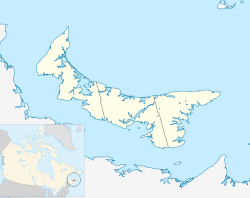RCAF Station Mount Pleasant was a Royal Canadian Air Force (RCAF) station in Mount Pleasant, Prince Edward Island, Canada. Two of its runways remain in use by members of the Experimental Aircraft Association.[2]
| RCAF Station Mount Pleasant | |||||||||||
|---|---|---|---|---|---|---|---|---|---|---|---|
| Near Ellerslie, Prince Edward Island in Canada | |||||||||||
| Coordinates | 46°35′54″N 064°00′24″W / 46.59833°N 64.00667°W | ||||||||||
| Site information | |||||||||||
| Owner | Dept of National Defence (Canada) | ||||||||||
| Airfield information | |||||||||||
| Elevation | 110 feet (34 m)[1] AMSL | ||||||||||
| |||||||||||
| Airfields | |||||||||||

World War II
editThe aerodrome opened during World War II in 1940 under the auspices of the British Commonwealth Air Training Plan (BCATP). It was intended to serve as a relief landing field for No. 9 Service Flying Training School, which was located at nearby RCAF Station Summerside.
In September 1943, RCAF Station Mount Pleasant evolved from a relief field to a full training facility when it began hosting No. 10 Bombing and Gunnery School (B&GS).[3] Aircraft used for this training include the Avro Anson, Fairey Battle, Bristol Bolingbroke and Westland Lysander. No. 10 B&GS ceased operation in June 1945.
The airfield was used as a storage depot for a short time before being decommissioned by the RCAF in 1947.
Aerodrome information
editThe airfield was constructed in the typical BCATP wartime pattern, with runways formed in a triangle. In approximately 1942 the aerodrome was listed at 46°36′N 64°00′W / 46.600°N 64.000°W with a Var. 25 degrees W and elevation of 110 feet (34 m). Three runways were listed as follows:[1]
| Runway name | Length | Width | Surface |
|---|---|---|---|
| 2/20 | 3,048 feet (929 m) | 150 feet (46 m) | Hard (asphalt) surfaced |
| 8/26 | 3,002 feet (915 m) | 150 feet (46 m) | Hard (asphalt) surfaced |
| 14-32 | 2,994 feet (913 m) | 150 feet (46 m) | Hard (asphalt) surfaced |
References
edit- ^ a b c d e Staff writer (c. 1942). Pilots Handbook of Aerodromes and Seaplane Bases Vol. 1. Royal Canadian Air Force. p. 32.
- ^ "A Short History of Abandoned and Downsized Canadian Military Bases - Introduction". Military Bruce Historical Writings. Bruce Forsyth. Archived from the original on June 1, 2010.
- ^ Hatch, F. J. (1983). The Aerodrome of Democracy: Canada and the British Commonwealth Air Training Plan, 1939-1945. Ottawa: Directorate of History, Department of National Defence. ISBN 0660114437.
